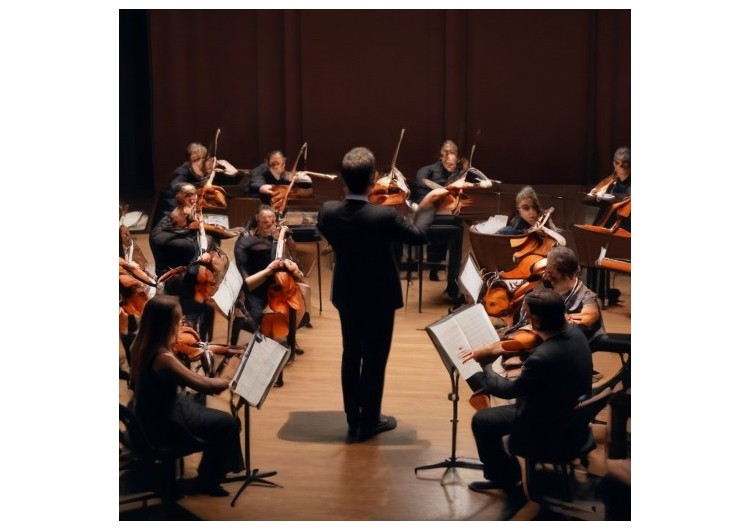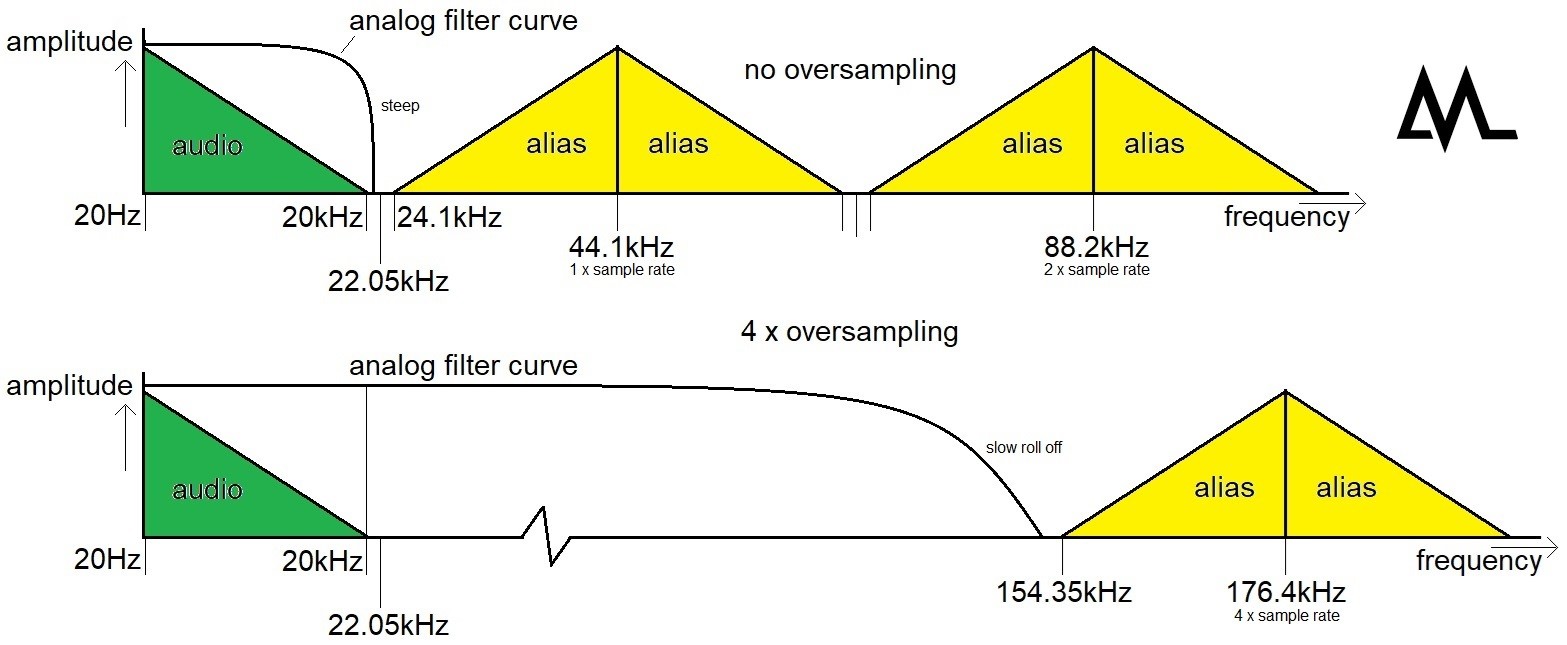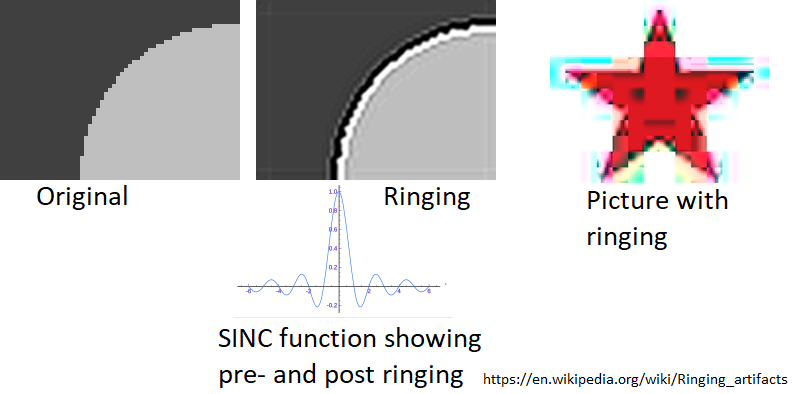Metrum Newsletter - November 2024

Metrum Acoustics explains why their DAC products sound different from other DAC topologies. The orchestra should be in focus!
All Metrum and Sonnet DAC products are digital-filter-less and NOS: Non OverSampling
Why do Metrum Acoustics and Sonnet Digital Audio DACs sound the way they sound? And how can their sound be described...
Digital to Analog Conversion the Metrum way: every bit of digital audio directly goes to the DAC modules. On the digital side, there is no processing, no filtering and no trickery whatsoever. This gives a distinctly different sound when compared to oversampling DACs. The sound is True to Nature, vivid, playful and Musical.
To explain the difference between oversampling and non-oversampling DACs, first, we have to explain what PCM sampling is and how it is helpful. Sampling is done to convert a continuous analog signal to a coded digital signal (note that DSD encoding is a different type of animal, which will not be discussed in this article). Every sample that is needed to rebuild the analog signal is taken from that analog signal, at fixed time intervals. Transmitting a signal digitally has a lot of advantages, like less signal degradation when transmitting an audio signal to the other side of the globe. Copper cables attenuate high-frequency signals, acting as a low-pass filter, so if one would make an analog long-distance phone call and thus transmit an analog signal over a large distance, high frequencies would be significantly damped, making the voice of the speaker muffled and unintelligible, rendering our long-distance phone call useless. So digital helps us out here and makes phone calls to the other side of the world (as well as the internet) possible. Moreover, computers only understand binary code, not analog. Sampling makes the transport and distribution of signals and content much easier, but we need to convert back to analog before this becomes useful and in turn, audible. To convert from Digital to Analog, a Digital to Analog Converter (or DAC) is needed. DACs come in multiple flavors, where one distinction is oversampling versus non-oversampling.
What happens when you convert from Digital to Analog?
The goal is to get the original signal back, preferably with as little distortion, and also as little effort as possible. Added bonus is that when digital goes back to analog it brings along mirror images of the analog signal that is to be reconstructed. These are called aliases and are depicted in yellow. In theory, they occur at every 44.1kHz interval (at a 44.1kHz sampling rate). Although these are not audible, good engineering practice says we filter them out. You can imagine that the filter should be pretty sharp (or steep) in the upper picture, where in the lower picture the space between audio frequencies (20Hz-20kHz) and the first alias increases, making the aliases simpler to filter out (slow roll-off). In some DAC implementations, you can choose the filter, each sounding different.

Sampling and oversampling - the differences are striking
Why implement oversampling and what does it do?
Oversampling is the practice of doing a 'mathematical trick' on a digitized signal that shifts aliases up in frequency, making the filtering stage after DA conversion simpler. An analogy can be made with film projected cinema (24Hz) where double (48Hz) or even triple (72Hz) projection was used to remove image flicker. Oversampling helps to more easily remove higher-order harmonics that weren't there in the original signal. So the practice of oversampling can help in the frequency domain.
Why would you need digital filtering and what does it do?
Filters are usually implemented to remove unwanted content from a signal. For example, high-frequency components (just like with a low-pass filter before a woofer). In the case of Digital to Analog Conversion, high-frequency aliases are removed from the digital signal, as a means to improve the analog frequency response of (for example) a CD player. This changes the digital signal, so it’s no longer bit-perfect, but it does help in the frequency domain. Using digital filtering can result in very low distortion figures since harmonics are lowered in strength.
Reasons not to implement oversampling or a digital filter:
As discussed, digital filtering can help in the frequency domain, but in the time domain it adds problems. Industry-standard measurements usually don't reveal problems in the time domain because we measure with continuous sinusoidal signals, hiding the gremlins from plain sight. The 'problem' is that we don’t know what to look or listen for in a world that is dominated by (usually) simpler and cheaper oversampling DACs that measure well. An analogy with amplifiers would be the difference between a single-ended class A amp (fluent, lively, no feedback) and early class D designs (great for low frequencies, but muffled and un-lively on the high frequencies). Once you hear what oversampling does to reproduced Music it is easily discernable. It is like looking at a blurred picture, where you can't clearly see where one object starts and the other stops. Oversampling leads to a loss in livelihood, a loss in naturality and Musicality. It misses that ‘glow‘ you can sometimes observe in fresh lovebirds. When the love‘s there you immediately know it. If it’s not there... it leaves us longing...
Usually, the practice of oversampling and digital filtering go hand in hand. Some manufacturers increase computational power and try to mitigate problems in the timing domain, but a trained ear can still hear the artificial or blurred and wrinkly edge that is added. For Metrum Acoustics, “It's not what you put in your product, but what you decide to leave out”.
A short history lesson that adds to knowledge and entertainment...
In the beginning of the CD (when CDs started roaming the earth), when they were 14 bits instead of 16 bits, the TDA1540 mono DAC chip was the pinnacle of what was technologically possible. After hard engineering work, the TDA1541 saw the light and delivered 16 bits of pure stereo bliss! Performance was better than what anyone would ever need (just like we allegedly don't need more than 640k of RAM in a computer), the sound was crystal clear and the noise floor was so low you could hear a pin drop. Both the TDA1540 and its newer stereo sibling TDA1541 are R2R DAC chips. R2R is a ladder of resistive elements that can be turned on or off, which means that a calibrated (weighted) current (current and voltage lead to power, which is electrical energy) can be added to the grand total of the output with every bit that is turned on in the digital code that was input to the DAC chip. So, if your code is all zero, the output is zero. If the code is all ones (except for the sign bit), the output is at maximum level because all current sources are turned on and are added to the total of the output. The PCM samples, in turn, turn the 44100 pieces of code per second back into a reconstructed analog signal. An example of an R2R ladder can be found at the bottom of our October 2023 newsletter.
The TDA1541 could be used for 44.1kHz sampling rates, although it allowed for a maximum sampling rate of 200 kHz. An input sampling rate of 44.1kHz, and a 44.1kHz digital signal reaching the DAC chip essentially means that no oversampling is applied. A steep analog filter was used to filter out high-frequency content (or aliases because they have the same spectrum as the audio band signal, just copied and repeated at higher frequencies). Philips engineers improved the frequency response by embracing oversampling digital filters, effectively making the task of the analog filter simpler, in turn improving the frequency response and distortion measurements. There was room to oversample the 44.1 kHz signal 4 times, ending up with a sample rate of 176.8 kHz internally (8 times oversampling was possible by staggering the DACs). The DAC chips would then convert the signal at this higher rate.
Back to (digital) filtering, because that is a very relevant topic, especially for digital-filter-less NOS DACs. The steep brick wall filter was 'needed' to remove so-called aliases (mirrors of the 20Hz - 20kHz spectrum, just higher in frequency) that arise when a digital signal is converted into analog; note that this is part of the reconstruction process of an Analog signal and is unavoidable. This is usually seen on a spectrum analyzer as 'out of band' noise (artifacts above 20kHz). Some people think we hear absolutely nothing above 20kHz, but at the same time think these measurable (high-frequency) artifacts are undesirable, so ever complexer and more invasive filters were developed. Side note: the aliases correlate perfectly with the audio band, so they are not perceived as intrusive, which means they are not audible. Simple implementations used the work of mathematician Butterworth (using more orders for the desired effect), where steeper filters could be achieved with Chebyshev-type filtering, at the cost of passband ripple. More implementations and flavors are available, but what most of these filters have in common is that they have a non-linear phase response, which implies that bass and treble don't arrive at the same time when Music is played through your speakers. Some loudspeaker manufacturers that did their homework take great care in making phase-linear (or time-aligned) loudspeakers, so why circumvent it in the electrical domain?
Intermezzo: NOS DACs are usually associated with treble roll-off and measure rather poor. Higher-order filters (that introduce increasingly larger phase-shift) are implemented too close to the Nyquist frequency (22.05 kHz for 44.1kHz sampling) in an attempt to minimize high-frequency aliases while getting better distortion figures. At Metrum Acoustics, we operate in a sweet spot that doesn't give roll-off in the treble, as well as respectable distortion (THD) measurements. Remember that the aliases are correlated with the analog audio signal, so they are not perceived as intrusive. As with all things in life, it is a trade-off and we chose for accurate timing, at the cost of slightly higher measured distortion.
Types of digital filters
Digital filters, sometimes also called equalizer or EQ, come in several flavors. The length of the filter defines its strength (longer filters are more powerful because they can work their magic on the signal for longer), but also its latency (longer filters take longer for a signal to pass through). Another specification of a digital filter is being 'with feedback' (recursive = IIR) or 'without feedback' (non-recursive = FIR). It is easier (and thus cheaper) to make a steep filter with recursive filters (IIR) than with non-recursive (FIR) filters. This implies that fewer so-called filter taps are needed, making a shorter filter with fewer components, less silicon or fewer computations (and thus cheaper). Why is that? Without going into the mathematics of the matter, you can imagine that if you have a signal and you need to process it, it is easier to do that with a short filter, requiring fewer calculations (rather than more). Recursive also implies that signals are processed by the same piece of filter several times (to emulate a longer and thus more powerful filter), just later in time, and with gradually lower impact. IIR filters are also known to introduce timing errors in the form of a pre-and post-ringing 'echo' due to the shape of the SINC function. The images show that an IIR-filtered impulse signal is preceded by a growing (crescendo) sound wave, as well as trailed by that same sound wave. Symmetry is beautiful, but in this case, it does more harm than good because artifacts are introduced at the cost of accurate timing and phase response. A special type of filter called the apodizing filter removes the pre-trail and moves it to the back of the impulse. Audibly this is perceived as better-sounding, but you’re still adding a post-ringing tail. Great, all this knowledge, but can't you explain it to me in a way that I can see, hear or understand?
What does pre-ringing sound or look like?
Let's dive into the visual domain for an analogy. Doctors doing diagnostics need very crisp images coming from an MRI scanner. The edge of a line must be very accurately visible to see the difference between tissues. Is that a line, or isn't it? Images with oversampling (which translates to ghost-edges due to pre- or post-ringing) are undesirable and could lead to an improper representation of what is going on in the patient, and thus a wrong diagnosis. The SINC function was placed under the image with ringing. The brightness of the rings ripple, just like the graph. The graph should show a so-called step-response to completely correspond with the picture, but is informative nonetheless.

Ringing made visual
Another analogy to pre-ringing is throwing a rock into the water. This creates ripples that move outwards and subside slowly. If pre-ringing (due to digital filtering) was added to these ripples, the pre-ringing would precede the plunging rock and would be equal in strength to the natural post-ripples. In Music, this translates to a pre-signal that was not originally there and sounds unnatural, like the looks of our poor 'Christmas' star that was affected by ringing.
But how can we have a pre-signal if the original signal is not there yet? This is caused by the time delay that is introduced by any digital filter. The steeper (or longer) the filter, the more time delay, and the more time for the pre-ringing to grow in strength. The onset of a signal (i.e. a pulse) is put through the digital filter, rippling through the filter and causing disturbances that increase in intensity until the pulse passes through the filter completely. Then, the analog output also shows a bump in intensity and continues to ripple through with ever less intensity until the end of the filter. Sounds very mathematical, but this is what happens in most household CD players and off-the-shelf DAC chips, even the exotic and expensive ones. Back to the audio domain and how to spot the differences.
Auditory perception
From auditory perception research, we know that the onset of a sound is very determinative for sound localization, i.e.: it helps us to distinguish where the sound originated from. Several names are coined for this effect, like the Haas effect and the first wavefront theory (for more information, see books on Auditory Perception by Richard Warren). The precedence effect finally, describes that sounds that are close together in time are perceived to 'belong' together, even if they originated from different sources (due to reflection off a wall, or even when they come from the other speaker). An experiment of the imagination can then tell us that inaccurately timed sounds from both speakers can 'stick together' and produce inaccurately spaced sounds as a result. To be able to laser-accurately pinpoint where a sound is coming from, a consistent and accurate first wave-front is needed. Not a muddled wavefront that pre-announces itself, then rises with a slope that approximates the musical signal and then ripples again on its way out. Remember that jitter is undesirable? Jitter and pre-ringing are not the same, but they do negatively influence the way we perceive Music. Metrum and Sonnet DACs don't have pre-ringing due to digital filtering, which is why we have very True to Nature and analog sounding, Musical DACs.
It is also why studio engineers like our DACs. The timing is correct over the audible range and studio engineers can accurately hear what they're doing, especially with live to 2-track recordings that need equalization or in a multitrack mix when dynamic compression, exciters or stereo expanders are added. Salient detail; since our DACs don't use a digital filter, latency is very low, which is needed when making recordings using headphone monitoring for the performing artist.
Back to Analog
On the analog side is where stuff gets even more interesting. At Metrum Acoustics we stack our R2R DAC ladders so we can build a true 24-bit DAC that can convert and extract 22 bits of that data. The lowest 2 out of 24 bits are overcome by noise, so they don’t add to linearity and you can't hear or measure them. Please note that the Johnson noise of a 1000 ohm resistor is already higher than the noise level at the output of the Pasithea DAC (which is quite a feat!).
Volume is controlled by adjusting the reference voltage to the top of the ladder (see our October 2023 newsletter about that). Off-the-shelf audio DAC chips don't offer this functionality, but since we build everything ourselves, from scratch, we can. The result is a very neutral and distortion-free volume control that is bit-perfect because we don't change any bits! If you want to use a pre-amplifier with your DAC you still can, just turn the volume of the DAC all the way up. Obviously, when you're playing at VERY low volumes you will measure relatively more switching noise. This means that at whispering volumes you'll lose a bit or two of resolution because of the relatively higher noise. Switching noise has the same character as white noise (same strength over all audio frequencies), which introduces a masking effect. This implies that you won't be bothered by it.
Did we already tell you our DACs are NOS? No Ordinary Stuff
We measured our DACs any way we could and found the noise floor to be at an exceptional -160dB when digital input is at -90dB. There are not many DACs around that perform at this level while keeping the timing of the music intact. Oversampling and digital filtering change the timing response of the system by adding unnatural pre-and post-ringing, resulting in a less sharp image of an orchestra. The phase response of the system is no longer linear; bass and treble are no longer time-aligned. Rinse and repeat: some speaker manufacturers take great care to keep their speakers time-aligned by making complex cross-overs. We do our part and go to great lengths with our electronics to keep the phase coherent; the phase difference is about 5 degrees over the audible range.
Fun facts:
- The TDA1541 is the mother of all DAC chips, is legendary and could be operated in NOS mode.
- According to It's only Audio (4m24s), there is a TDA1541, made on breadboards, hanging on a wall at Philips.
- There were S1 and S2 versions of the TDA1541; the S1 had a single crown, and the S2 had a double crown, indicating these chips were Select. Now unobtanium, but if you are offered some, double check if the markings of the crown(s) is of the same vintage as the type markings.
- Early implementations of digital audio were judged to sound cold. To mitigate the 'digital edge' and add warmth and ‘glow‘ tube microphones were reinstated, raising prices on mics that were discarded as obsolete technology earlier.
- Staggering (or paralleling) of DAC chips was done to get better linearity, dynamic range and ultimately, better resolution.
- Along came Cees Ruijtenberg, stacking R2R DACs differently, leading to 24-bit data paths and almost 24 bits of linearity. The result was DAC2: (un)heard of and written about. Currently, DAC3 is the top of the line.
The holiday season
For the upcoming holiday season, we have a special offer for you, our fellow Music enthusiasts!
The Metrum Jade and Metrum Onyx will be available at a 10% discount, in any configuration (color, voltage, DAC module type and input module type).

Holiday offers
Jade and Onyx are basically the same DAC and thus sound the same. The difference is that the Jade has integrated volume control by changing the reference voltage to the DAC. This implies that all data bits that enter the DAC are unaltered, remaining bit-perfect. Moreover, there is no potentiometer and accompanying buffer in the signal path. The outputs of the DAC modules are directly coupled to the outputs on the back! This is economical for Music lovers that would like to change their setup to monoblock amplifiers in the future, because then no pre-amplifier is needed, adding to the transparency of the system as a whole!
The award-winning Acelec Model One loudspeakers are also discounted by 10%.
Read more about our small but astounding loudspeaker in the Stereophile review:
"The Acelec speaker's cumulative spectral-decay, or waterfall, plot is impressively clean."
"The Acelec Model One offers excellent measured behavior."
Panel resonance is "extraordinarily low in level."
Note that this highly revered speaker is in Stereophiles' recommended components section for 2023 and 2024.
The accompanying Monitor Audio STAND is out of production, the alternative is the STUDIO 89 loudspeaker stand, which is practically the same loudspeaker stand. The hole pattern on the bottom of the Acelec Model Ones fits perfectly!
Both our discount actions are valid from when you read this newsletter until we run out of stock, or until January 30th, 2024, so we even cover the Chinese New Year.








